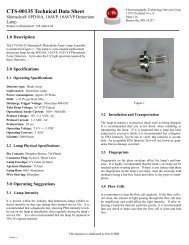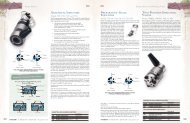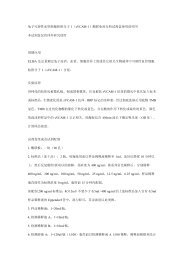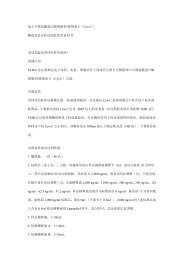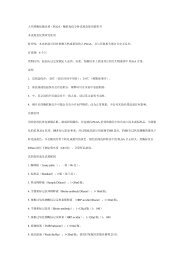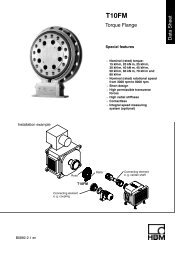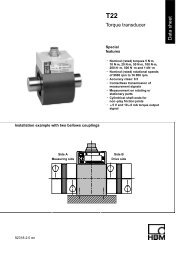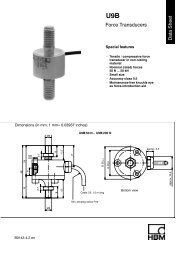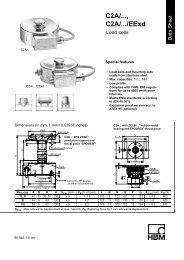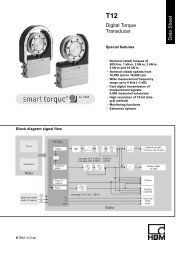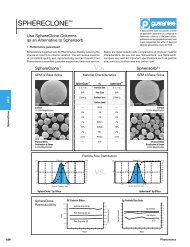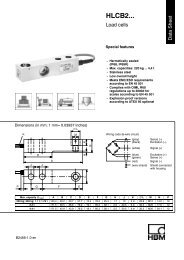Is it still possible, necessary and beneficial to perform research in ...
Is it still possible, necessary and beneficial to perform research in ...
Is it still possible, necessary and beneficial to perform research in ...
You also want an ePaper? Increase the reach of your titles
YUMPU automatically turns print PDFs into web optimized ePapers that Google loves.
PERSPECTIVE<br />
<strong>Is</strong> <strong>it</strong> <strong>still</strong> <strong>possible</strong>, <strong>necessary</strong> <strong>and</strong> <strong>beneficial</strong> <strong>to</strong> <strong>perform</strong> <strong>research</strong> <strong>in</strong><br />
ICP-a<strong>to</strong>mic emission spectrometry?<br />
J. M. Mermet<br />
www.rsc.org/jaas<br />
Labora<strong>to</strong>ire des Sciences Analytiques (UMR CNRS 5180), Univers<strong>it</strong>e´ Claude Bernard-Lyon 1,<br />
F-69622 Villeurbanne Cedex, France<br />
Received 27th Oc<strong>to</strong>ber 2004, Accepted 19th November 2004<br />
First published as an Advance Article on the web 3rd December 2004<br />
DOI: 10.1039/b416511j<br />
Jean-Michel Mermet is Research Direc<strong>to</strong>r at the National<br />
Center for Scientific Research (CNRS). He was born <strong>in</strong> Lyon,<br />
France, conducted his graduate<br />
degree work at the<br />
Univers<strong>it</strong>y of Strasbourg <strong>in</strong><br />
1964, received his doc<strong>to</strong>r’s<br />
degree <strong>in</strong> chemistry from<br />
the Univers<strong>it</strong>y of Lyon <strong>in</strong><br />
1974, <strong>and</strong> worked as postdoc<strong>to</strong>ral<br />
fellow at the Univers<strong>it</strong>y<br />
of Florida <strong>in</strong> 1977<br />
w<strong>it</strong>h Prof. J. D. W<strong>in</strong>efordner.<br />
In 1985, he was appo<strong>in</strong>ted<br />
Direc<strong>to</strong>r of the<br />
Labora<strong>to</strong>ry of Analytical<br />
Sciences at the Univers<strong>it</strong>y<br />
of Lyon. His <strong>research</strong> <strong>in</strong>terests<br />
have been focused on<br />
the spectrochemistry of plasmas <strong>and</strong> lasers from fundamental,<br />
analytical <strong>and</strong> <strong>in</strong>strumental aspects. He has published more than<br />
200 papers, reviews <strong>and</strong> book chapters.<br />
Introduction<br />
‘‘Noth<strong>in</strong>g tends so much <strong>to</strong> the advancement of knowledge as the<br />
application of a new <strong>in</strong>strument’’.<br />
Sir Humphry Davy<br />
It is often said that there is no more need for <strong>research</strong> <strong>in</strong><br />
a<strong>to</strong>mic emission spectrometry (AES), <strong>and</strong> that <strong>it</strong> is a dead-end<br />
street. Therefore, a question could be raised: <strong>Is</strong> <strong>it</strong> <strong>still</strong> <strong>possible</strong>,<br />
<strong>necessary</strong> <strong>and</strong> <strong>beneficial</strong> <strong>to</strong> <strong>perform</strong> <strong>research</strong> <strong>in</strong> a<strong>to</strong>mic emission<br />
spectrometry? Actually this question conta<strong>in</strong>s some keywords.<br />
‘‘Possible’’ implies that f<strong>in</strong>ancial support may be<br />
obta<strong>in</strong>ed <strong>to</strong> conduct <strong>research</strong> regardless of the orig<strong>in</strong> of the<br />
support, i.e., national or <strong>in</strong>ternational agencies, <strong>in</strong>strument<br />
companies, or <strong>in</strong>dustry. ‘‘Necessary’’ means that strong needs<br />
can be def<strong>in</strong>ed by users or <strong>in</strong>strument companies, or are<br />
required because of new regulations. ‘‘Beneficial’’ means that<br />
this type of <strong>research</strong> is recognized through conferences, scientific<br />
journals <strong>and</strong> awards, <strong>and</strong> that students prepar<strong>in</strong>g a PhD<br />
thesis on this subject would easily f<strong>in</strong>d a job correspond<strong>in</strong>g <strong>to</strong><br />
their expertise. More complex is what should be ‘‘<strong>research</strong>’’ <strong>in</strong><br />
analytical chemistry, <strong>and</strong> <strong>in</strong> particular <strong>in</strong> AES. In contrast <strong>to</strong><br />
what non-analysts th<strong>in</strong>k, <strong>research</strong> cannot be conf<strong>in</strong>ed <strong>to</strong> the<br />
use of an analytical method, as sophisticated as <strong>it</strong> might be. It is<br />
similar w<strong>it</strong>h computers: us<strong>in</strong>g complex softwares does not<br />
mean that we are computerists.<br />
Interest <strong>in</strong> AES<br />
‘‘A<strong>to</strong>mic emission spectrometry’’ is a field that academic<br />
people may consider as old fashioned compared w<strong>it</strong>h<br />
ICP-MS, as AAS could have been once w<strong>it</strong>h AES. It is true<br />
that AES is one of the oldest analytical <strong>in</strong>strumental techniques,<br />
as the early work started <strong>in</strong> the 1800s. Almost every<br />
pr<strong>in</strong>ciple had been already described dur<strong>in</strong>g the 19th century,<br />
i.e., l<strong>in</strong>e specific<strong>it</strong>y <strong>and</strong> quant<strong>it</strong>ative analysis, along w<strong>it</strong>h <strong>in</strong>strument<br />
developments such as the pneumatic nebulizer,<br />
although most physical concepts could not be unders<strong>to</strong>od<br />
because of the lack of knowledge of physics. For <strong>in</strong>stance,<br />
the discovery of the electron was only made <strong>in</strong> 1897 by<br />
Thomson. Except probably the concept of <strong>in</strong>ternal st<strong>and</strong>ardization<br />
by Gerlach, 1 <strong>and</strong> that of lim<strong>it</strong> of detection by Kaiser, 2<br />
most improvements were related <strong>to</strong> the technique: development<br />
of new radiation sources, more efficient <strong>and</strong> reliable sample<br />
<strong>in</strong>troduction systems, the <strong>in</strong>troduction of grat<strong>in</strong>gs <strong>in</strong> the dispersive<br />
systems <strong>and</strong> pho<strong>to</strong>-electric detection such as the pho<strong>to</strong>multiplier<br />
tube (PMT) <strong>in</strong> 1935, <strong>and</strong> charge transfer device<br />
detec<strong>to</strong>rs <strong>in</strong> the 1980s. 3<br />
The advantages of AES are well known: pho<strong>to</strong>ns can easily<br />
travel <strong>and</strong> be collected w<strong>it</strong>h simple optics, they do not exhib<strong>it</strong><br />
memory effects or degrade detec<strong>to</strong>rs, <strong>and</strong> various detec<strong>to</strong>rs are<br />
available, <strong>in</strong>clud<strong>in</strong>g array or 2D detec<strong>to</strong>rs. Besides, depend<strong>in</strong>g<br />
on the radiation source, the spectrum of each element present<br />
<strong>in</strong> the sample can be obta<strong>in</strong>ed, which results <strong>in</strong> an <strong>in</strong>herent<br />
multi-element technique. AES is widely used for elemental<br />
analysis <strong>in</strong> the rout<strong>in</strong>e labora<strong>to</strong>ry. The need for elemental<br />
analysis will rema<strong>in</strong> for ever as the determ<strong>in</strong>ation of elements<br />
<strong>in</strong> various matrices will always be a request. The only change<br />
will be a trend <strong>to</strong> determ<strong>in</strong>e more <strong>and</strong> more elements w<strong>it</strong>h<br />
lower <strong>and</strong> lower concentrations, <strong>in</strong> more <strong>and</strong> more complex<br />
matrices, w<strong>it</strong>h a dem<strong>and</strong> for more <strong>in</strong>formation such as speciation<br />
(for bioavailabil<strong>it</strong>y <strong>and</strong> <strong>to</strong>xic<strong>it</strong>y reasons) <strong>and</strong> structure.<br />
Because there are not so many multi-element techniques, there<br />
is <strong>still</strong> room for AES, provided that <strong>it</strong> will be the subject of<br />
further improvements.<br />
Interest <strong>in</strong> ICP-AES<br />
Many radiation sources have been described w<strong>it</strong>h the follow<strong>in</strong>g<br />
be<strong>in</strong>g the most popular: spark, glow discharge, laser-produced<br />
plasma, electrical field-produced plasmas such as the microwave<br />
<strong>in</strong>duced plasma <strong>and</strong> the <strong>in</strong>ductively coupled plasma<br />
(ICP). Each of them has <strong>it</strong>s own advantages, but an ICP has<br />
some def<strong>in</strong><strong>it</strong>ive advantages. An ICP is a highly efficient a<strong>to</strong>mization<br />
source, which means that every molecule should be<br />
dissociated provided that operat<strong>in</strong>g cond<strong>it</strong>ions are optimized<br />
for this purpose. The ionization efficiency is also high, which<br />
justify the use of ICP as an ionization source <strong>in</strong> <strong>in</strong>organic mass<br />
spectrometry. Besides, because of the sk<strong>in</strong> effect, the sample is<br />
conf<strong>in</strong>ed along a central channel, which facil<strong>it</strong>ates pho<strong>to</strong>n<br />
prob<strong>in</strong>g, regardless of the view<strong>in</strong>g mode, radial or axial. Also,<br />
the ICP exhib<strong>it</strong>s an excellent <strong>to</strong>lerance <strong>to</strong> high salt concentration:<br />
as a consequence, lim<strong>it</strong>s of detection <strong>in</strong> a solid prior <strong>to</strong><br />
digestion are excellent.<br />
This journal is & The Royal Society of Chemistry 2005 J. Anal. At. Spectrom., 2005, 20, 11–16 11
Fig. 1<br />
Number of publications per year published <strong>in</strong> JAAS: &, ICP-AES; ’, ICP-MS.<br />
However, ICP-AES suffers from some lim<strong>it</strong>ations: the LOD<br />
are excellent for light elements, but are not satisfac<strong>to</strong>ry enough<br />
for elements such as As, Se, Pb...Spectral <strong>in</strong>terferences due <strong>to</strong><br />
spectrum richness, l<strong>in</strong>e broaden<strong>in</strong>g <strong>and</strong> <strong>in</strong>sufficient resolution<br />
can hamper the analysis w<strong>it</strong>h matrices such as Co, Fe, Mo, Nb,<br />
Ta, U, V, W <strong>and</strong> some rare earth elements. Non-spectral<br />
matrix effects are usually low, but present, which makes them<br />
dangerous as the effects are not always obvious. This last<br />
lim<strong>it</strong>ation is probably the most crucial one.<br />
On the whole, the use of ICP-AES <strong>in</strong> rout<strong>in</strong>e <strong>and</strong> <strong>research</strong><br />
labora<strong>to</strong>ries is perfectly justified, which is illustrated by the<br />
worldwide market that is about 1400 un<strong>it</strong>s a year, correspond<strong>in</strong>g<br />
<strong>to</strong> a turnover of about 120M$.<br />
In terms of publications, <strong>it</strong> could be thought that the<br />
<strong>in</strong>troduction of ICP-MS led <strong>to</strong> a decrease <strong>in</strong> the number of<br />
ICP-AES papers. If we select a journal such as JAAS, where a<br />
large number of ICP-MS papers are published, <strong>it</strong> is <strong>in</strong>terest<strong>in</strong>g<br />
<strong>to</strong> see that, although the number of ICP-MS publications is <strong>still</strong><br />
grow<strong>in</strong>g, the number of ICP-AES papers has not varied<br />
drastically over the past 20 years (Fig. 1).<br />
Basically, an ICP-AES system has rema<strong>in</strong>ed the same s<strong>in</strong>ce<br />
<strong>it</strong>s <strong>in</strong>troduction: a hf genera<strong>to</strong>r, a pneumatic nebulizer associated<br />
w<strong>it</strong>h a spray chamber, a <strong>to</strong>rch, a dispersive system, a<br />
detec<strong>to</strong>r <strong>and</strong> a computer for data acquis<strong>it</strong>ion <strong>and</strong> process<strong>in</strong>g.<br />
The system can be partially or fully computer-driven. Major<br />
changes have centred on the detection level, w<strong>it</strong>h some consequences<br />
on the optical mount<strong>in</strong>g of the dispersive system.<br />
Before the 1990s, dispersive systems were e<strong>it</strong>her monochroma<strong>to</strong>rs<br />
(so-called sequential systems) or polychroma<strong>to</strong>rs (socalled<br />
simultaneous systems). Both types were equipped w<strong>it</strong>h<br />
PMTs. Most polychroma<strong>to</strong>rs were based on the Paschen–Runge<br />
optical mount<strong>in</strong>g, w<strong>it</strong>h the PMTs set up on the Rowl<strong>and</strong> circle.<br />
The commercial <strong>in</strong>troduction of solid state detec<strong>to</strong>rs, first of<br />
the pho<strong>to</strong>diode type, then of the CTD type, e<strong>it</strong>her CCD or<br />
CID, has revived echelle grat<strong>in</strong>g-based dispersive systems, w<strong>it</strong>h<br />
most of them mak<strong>in</strong>g use of a post-cross-dispersion <strong>to</strong> obta<strong>in</strong> a<br />
2D spectrum. Even the Rowl<strong>and</strong> circle is now equipped w<strong>it</strong>h a<br />
l<strong>in</strong>ear assembly of CCD arrays. As a consequence, conventional<br />
polychroma<strong>to</strong>rs, i.e., those equipped w<strong>it</strong>h PMTs, almost<br />
disappeared from the market, <strong>and</strong> sequential systems, which<br />
represented about two-third of the market at the end of the<br />
1980s, were overpassed by the new polychroma<strong>to</strong>r generation<br />
<strong>in</strong> 1992–1993. Note that there is a dispersive system <strong>in</strong>termediate<br />
between a monochroma<strong>to</strong>r <strong>and</strong> polychroma<strong>to</strong>r: the system<br />
is mak<strong>in</strong>g use of a multichannel CTD detec<strong>to</strong>r, <strong>and</strong> <strong>in</strong>stead of a<br />
s<strong>in</strong>gle narrow b<strong>and</strong>pass at a time, a more or less wide spectral<br />
w<strong>in</strong>dow is selected <strong>and</strong> moves sequentially.<br />
Research <strong>in</strong> ICP-AES<br />
Research may <strong>in</strong>clude: (i) search for new physical/chemical<br />
processes that can be used for analytical chemistry; (ii) underst<strong>and</strong><strong>in</strong>g<br />
of the processes; (iii) development of the method; <strong>and</strong><br />
(iv) method validation. More details are given <strong>in</strong> Table 1. Note<br />
that an efficient <strong>research</strong> study should also imply transfer <strong>and</strong><br />
dissem<strong>in</strong>ation of knowledge <strong>and</strong> results <strong>to</strong> students, users,<br />
<strong>in</strong>strument companies, normalization bodies...<br />
It is obvious that the vast major<strong>it</strong>y of publications is related<br />
<strong>to</strong> applications. To illustrate the various fields of <strong>research</strong>,<br />
Fig. 2 gives the number of publications for some fields such as<br />
fundamentals, i.e., non-spectral matrix effects, exc<strong>it</strong>ation mechanisms<br />
<strong>and</strong> <strong>in</strong>ternal st<strong>and</strong>ardization, <strong>and</strong> <strong>in</strong>strumentation,<br />
i.e. axial view<strong>in</strong>g, micronebulization, laser ablation, hydride<br />
<strong>and</strong> vapour generation, <strong>and</strong> electrothermal vaporization. Also,<br />
as an example of data process<strong>in</strong>g, the number of papers related<br />
Table 1<br />
Possible fields of <strong>research</strong> <strong>in</strong> a<strong>to</strong>mic emission spectrometry<br />
Search for new physical/chemical processes<br />
Underst<strong>and</strong><strong>in</strong>g of the<br />
processes<br />
Development of the<br />
method<br />
Method validation<br />
Diagnostics<br />
Mechanisms<br />
Modell<strong>in</strong>g<br />
Non-spectral matrix effects<br />
Internal st<strong>and</strong>ardization<br />
Instrumentation<br />
Data process<strong>in</strong>g, <strong>in</strong>formation retrieval,<br />
chemometrics<br />
Analytical results<br />
Optimization<br />
Applications <strong>to</strong> illustrate the potential<br />
<strong>and</strong> the current lim<strong>it</strong>s of the methods<br />
Analytical <strong>perform</strong>ance<br />
Uncerta<strong>in</strong>ty <strong>and</strong> traceabil<strong>it</strong>y<br />
L<strong>in</strong>ear<strong>it</strong>y of the calibration graph<br />
12 J. Anal. At. Spectrom., 2005, 20, 11–16
Fig. 2 Number of ICP-AES publications related <strong>to</strong> matrix effects<br />
(MX), mechanisms (ME), <strong>in</strong>ternal st<strong>and</strong>ardization (IS), acid effects<br />
(AC), qual<strong>it</strong>ative analysis (QA), axial view<strong>in</strong>g (AX), electrothermal<br />
a<strong>to</strong>mization (ET), hydride <strong>and</strong> vapor generation (HG), laser ablation<br />
(LA), micronebulization (MN) <strong>and</strong> speciation (SP).<br />
<strong>to</strong> qual<strong>it</strong>ative analysis is given. These figures were extracted<br />
from over 2300 ICP-AES publications s<strong>to</strong>red <strong>in</strong> my own<br />
database.<br />
Over this number of publications, a similar number of<br />
roughly 500 ICP-AES publications have been published <strong>in</strong> the<br />
Journal of Analytical <strong>and</strong> A<strong>to</strong>mic Spectrometry <strong>and</strong> <strong>in</strong> Spectrochimica<br />
Acta, Part B (Fig. 3).<br />
Note that the classification was not based on keywords, but<br />
on my own perception of the contents of the papers. However<br />
arb<strong>it</strong>rary <strong>it</strong> might be, <strong>it</strong> is nevertheless an <strong>in</strong>dica<strong>to</strong>r of the past<br />
<strong>research</strong> <strong>in</strong> ICP-AES. A hundred papers on non-spectral matrix<br />
effects means that less than 5% of those papers have been<br />
related <strong>to</strong> this field. It can be easily unders<strong>to</strong>od that only very<br />
few labora<strong>to</strong>ries have the expertise <strong>to</strong> run diagnostics based on<br />
Thomson scatter<strong>in</strong>g because of the complex set-up, along w<strong>it</strong>h<br />
the need <strong>to</strong> adapt the <strong>in</strong>strument for this purpose. In contrast,<br />
most of the studies on matrix effects, at least <strong>in</strong> terms of results,<br />
could be <strong>perform</strong>ed on commercially available <strong>in</strong>struments by<br />
any analyst will<strong>in</strong>g <strong>to</strong> do <strong>it</strong>. Interest<strong>in</strong>g <strong>to</strong> note is that axial<br />
view<strong>in</strong>g is the default view<strong>in</strong>g mode for most systems that are<br />
currently commercialized. However, less than 60 papers dealt<br />
w<strong>it</strong>h the <strong>in</strong>fluence or the role of such a view<strong>in</strong>g mode.<br />
A large number of papers are concerned w<strong>it</strong>h alternative<br />
sample <strong>in</strong>troduction systems such as laser ablation, micronebulization,<br />
volatile species generation, electrothermal vaporization.<br />
First, a need exists for the replacement of the<br />
conventional pneumatic nebulizer. Then, <strong>it</strong> is probably the<br />
easiest part <strong>to</strong> modify on a commercially available system.<br />
Early <strong>research</strong> <strong>in</strong> the 1960s was based on the availabil<strong>it</strong>y of a hf<br />
Fig. 3 Number of ICP-AES publications aga<strong>in</strong>st the scientific journal.<br />
Note that the figure for Anal. Bioanal. Chem. conta<strong>in</strong>s also publication<br />
from the former Fresenius’ Z. Anal. Chem. <strong>and</strong> Fresenius’ J. Anal.<br />
Chem.<br />
genera<strong>to</strong>r e<strong>it</strong>her designed for <strong>in</strong>ductive heat<strong>in</strong>g (usually w<strong>it</strong>h a<br />
free-runn<strong>in</strong>g technology) of for broadcast<strong>in</strong>g (crystalcontrolled<br />
technology), a dispersive system equipped w<strong>it</strong>h<br />
pho<strong>to</strong>multiplier tube(s), <strong>and</strong> a simple acquis<strong>it</strong>ion system, for<br />
<strong>in</strong>stance a picoammeter associated <strong>to</strong> a chart recorder. Because<br />
systems were not computer driven w<strong>it</strong>h the absence of firmwares,<br />
<strong>and</strong> consisted of separated parts, <strong>it</strong> was relatively simple<br />
<strong>to</strong> modify the <strong>in</strong>strument configuration. Currently, apart the<br />
sample <strong>in</strong>troduction system, <strong>it</strong> is far more complex <strong>to</strong> modify a<br />
commercially available system.<br />
Evidently, applications are numerous <strong>and</strong> this field is currently<br />
the most popular <strong>and</strong> justifies the success <strong>and</strong> the high<br />
c<strong>it</strong>ation <strong>in</strong>dex of scientific journals such as JAAS. Surpris<strong>in</strong>gly<br />
enough, speciation has been the subject of almost 60 papers,<br />
although <strong>it</strong> could be thought that ICP-MS is the most appropriate<br />
<strong>in</strong>strument for this purpose. In contrast, the number of<br />
papers related <strong>to</strong> method validation, <strong>and</strong> <strong>in</strong> particular <strong>to</strong> the<br />
estimation of uncerta<strong>in</strong>ty budget, is almost below the lim<strong>it</strong> of<br />
detection.<br />
Rema<strong>in</strong><strong>in</strong>g challenges <strong>in</strong> ICP-AES<br />
Several reviews have been already devoted <strong>to</strong> the future of ICP-<br />
AES <strong>and</strong> related techniques. 4–7 The question has often be<br />
raised as <strong>to</strong> whether the future would be evolution or revolution.<br />
4 It is certa<strong>in</strong>ly easier <strong>to</strong> verify whether the current needs<br />
are fulfilled than <strong>to</strong> anticipate technological gaps. Most gaps<br />
are <strong>in</strong>herently unpredictable. However, <strong>it</strong> is always <strong>possible</strong> <strong>to</strong><br />
dream, <strong>and</strong>, for <strong>in</strong>stance, if a fully tunable UV-visible diode<br />
laser were <strong>to</strong> become available, <strong>it</strong> would revolutionize a<strong>to</strong>mic<br />
fluorescence spectrometry, while a multicathode PMT would<br />
allow the design of a dispersive system w<strong>it</strong>h sequential w<strong>in</strong>dows,<br />
keep<strong>in</strong>g the advantages of a PMT when compared <strong>to</strong><br />
CTD detec<strong>to</strong>rs.<br />
To extrapolate current <strong>research</strong>, <strong>it</strong> is convenient <strong>to</strong> def<strong>in</strong>e an<br />
ideal system for elemental analysis <strong>and</strong> <strong>to</strong> verify where the<br />
Table 2 Qual<strong>it</strong>y of the analytical results, analytical qual<strong>it</strong>y of the<br />
system, <strong>in</strong>strument operation characteristics, <strong>and</strong> economical aspects<br />
Qual<strong>it</strong>y of the<br />
analytical results<br />
Analytical qual<strong>it</strong>y<br />
of the system<br />
Instrument<br />
operation<br />
characteristics<br />
Economical<br />
aspects<br />
Accuracy <strong>and</strong> precision (<strong>in</strong>clud<strong>in</strong>g repetabil<strong>it</strong>y,<br />
<strong>in</strong>termediate precision <strong>and</strong> the various<br />
reproducibil<strong>it</strong>ies)<br />
Uncerta<strong>in</strong>ty <strong>and</strong> traceabil<strong>it</strong>y us<strong>in</strong>g the metrology<br />
approach<br />
Number of elements which can be determ<strong>in</strong>ed by<br />
the system, mostly related <strong>to</strong> the wavelength<br />
range<br />
Sens<strong>it</strong>iv<strong>it</strong>y <strong>and</strong> low lim<strong>it</strong>s of detection <strong>and</strong><br />
quant<strong>it</strong>ation<br />
Long-term stabil<strong>it</strong>y<br />
Selectiv<strong>it</strong>y, i.e., the abil<strong>it</strong>y <strong>to</strong> separate the analyte<br />
l<strong>in</strong>e from concom<strong>it</strong>ant l<strong>in</strong>es, which is related <strong>to</strong><br />
the practical resolution<br />
Robustness, i.e., the absence of non-spectral<br />
matrix <strong>and</strong> <strong>in</strong>terelement effects<br />
High l<strong>in</strong>ear<strong>it</strong>y <strong>and</strong> dynamic range<br />
Ease of operation<br />
Ease of ma<strong>in</strong>tenance<br />
Intelligent <strong>and</strong> fully au<strong>to</strong>mated system<br />
Use of any form of the sample, solid, liquid or gas<br />
Low sample consumption if any<br />
Low size <strong>and</strong> low floor space of the system<br />
Fast analysis <strong>and</strong> high sample throughput<br />
Reliabil<strong>it</strong>y<br />
Safety<br />
Low cap<strong>it</strong>al <strong>in</strong>vestment<br />
Low runn<strong>in</strong>g cost<br />
J. Anal. At. Spectrom., 2005, 20, 11–16 13
Table 3<br />
Rema<strong>in</strong><strong>in</strong>g fields of <strong>research</strong> <strong>in</strong> ICP-AES<br />
Plasma generation<br />
Sample <strong>in</strong>troduction system<br />
Pho<strong>to</strong>n collection <strong>and</strong><br />
detection<br />
Intelligent software<br />
Analytical <strong>perform</strong>ance<br />
Method validation<br />
Mixed-gas plasma<br />
Total-consumption system<br />
Chemical vapor generation<br />
Direct solid analysis<br />
Axial view<strong>in</strong>g<br />
Reduction <strong>in</strong> shot noise<br />
Improved solid-state detection<br />
Au<strong>to</strong>matic (multi)l<strong>in</strong>e selection<br />
Semi-quant<strong>it</strong>ative analysis<br />
True self-diagnostics<br />
Improvement <strong>in</strong> lim<strong>it</strong>s of detection<br />
Orig<strong>in</strong> <strong>and</strong> m<strong>in</strong>imization of matrix<br />
effects<br />
Guidel<strong>in</strong>e<br />
Uncerta<strong>in</strong>ty budget<br />
miss<strong>in</strong>g features are located. A system may be characterized by<br />
the qual<strong>it</strong>y of the analytical results, the analytical qual<strong>it</strong>y of the<br />
system, the <strong>in</strong>strument operation characteristics, <strong>and</strong> the economical<br />
aspects. Details are given <strong>in</strong> Table 2.<br />
Consider<strong>in</strong>g that the analyst is a problem solver <strong>and</strong> needs<br />
accurate <strong>and</strong> precise results, along w<strong>it</strong>h low lim<strong>it</strong>s of detection<br />
<strong>and</strong> quant<strong>it</strong>ation, some challenges rema<strong>in</strong> <strong>in</strong> ICP-AES <strong>and</strong> are<br />
summarised <strong>in</strong> Table 3.<br />
Hf genera<strong>to</strong>r design<br />
There is a need <strong>to</strong> design a hf genera<strong>to</strong>r that can easily accept<br />
significant changes <strong>in</strong> the load, e.g., wet versus dry aerosol,<br />
vapors, volatile organic solvents, large amounts of foreign<br />
gases, or simply change <strong>in</strong> the matrix nature or concentration<br />
<strong>in</strong> aqueous solutions, w<strong>it</strong>hout a change <strong>in</strong> the plasma characteristics<br />
such as temperature, electron number dens<strong>it</strong>y or<br />
spatial distribution. Note that the design may be adequate, but<br />
the f<strong>in</strong>al tun<strong>in</strong>g may have a drastic <strong>in</strong>fluence. Warm-up time<br />
<strong>and</strong> long term stabil<strong>it</strong>y are <strong>still</strong> of concern for obvious reasons.<br />
Sample <strong>in</strong>troduction systems<br />
Clearly, sample <strong>in</strong>troduction system is a field where there is the<br />
need for more flexibil<strong>it</strong>y <strong>and</strong> less sens<strong>it</strong>iv<strong>it</strong>y as regards the<br />
sample form. It seems surpris<strong>in</strong>g that most ICP-AES analysts<br />
are <strong>still</strong> us<strong>in</strong>g a concentric pneumatic nebulizer very similar <strong>in</strong><br />
design <strong>to</strong> that described by Gouy at the end of the 1800s.<br />
Although specifications are different, diesel eng<strong>in</strong>es have been<br />
the subject of significant improvements, mostly because of the<br />
very high-pressure <strong>in</strong>troduction system. We probably need <strong>to</strong><br />
have a closer look at the <strong>research</strong> <strong>perform</strong>ed <strong>in</strong> the aerosol<br />
formation field. 8 There is a dem<strong>and</strong> <strong>to</strong> design sample <strong>in</strong>troduction<br />
systems w<strong>it</strong>h a trend <strong>to</strong> <strong>to</strong>tal-consumption devices, produc<strong>in</strong>g<br />
e<strong>it</strong>her smaller droplets or directly vapor or volatile species,<br />
along w<strong>it</strong>h noise reduction. 9 This is justified by the coupl<strong>in</strong>g<br />
w<strong>it</strong>h separation methods (need for low flow rates), by the small<br />
amounts of sample <strong>in</strong> some fields such as biology <strong>and</strong> forensic<br />
sciences, <strong>and</strong> the need <strong>to</strong> suppress hazardous waste.<br />
Direct <strong>in</strong>jection is probably a way <strong>to</strong> pursue, if some current<br />
lim<strong>it</strong>ations can be overcome: <strong>to</strong>o a large solvent load<strong>in</strong>g, <strong>and</strong><br />
large size <strong>and</strong> high veloc<strong>it</strong>y of the droplets. An alternative is <strong>to</strong><br />
modify the role of the spray chamber, so that the chamber acts<br />
as an evaporation cav<strong>it</strong>y. This is <strong>possible</strong> because of the<br />
availabil<strong>it</strong>y of efficient micronebulizers.<br />
Chemical vapor <strong>and</strong> volatile species generation is a grow<strong>in</strong>g<br />
field. There is no more need for evaporation, <strong>and</strong> <strong>it</strong> is <strong>possible</strong><br />
<strong>to</strong> separate the analyte from the matrix. At least half of the<br />
elements of the periodic table have a volatile chemical form.<br />
Besides hydrides, <strong>it</strong> may be <strong>possible</strong> <strong>to</strong> form chelates, halides<br />
(AsCl 3 ), oxides (OsO 4 ), carbonyl ((Ni(CO) 4 ), alkyls w<strong>it</strong>h Cd,<br />
Hg, Pb, Se, Sn, S-conta<strong>in</strong><strong>in</strong>g compounds (H 2 S). Hydride<br />
generation has been extended <strong>to</strong> unconventional elements such<br />
as Ag, Au, Cd, Co, Cu, Ni, Sn, Zn, Os, Pd, 10 w<strong>it</strong>h Cd<br />
appear<strong>in</strong>g as one of the most successful generations. 11 Probably<br />
the most challeng<strong>in</strong>g <strong>research</strong> is <strong>to</strong> allow the simultaneous<br />
formation of several volatile species <strong>to</strong> keep the multi-element<br />
capabil<strong>it</strong>y of the ICP-AES. Moreover, as mentioned above,<br />
study of plasma characteristics w<strong>it</strong>h a sample <strong>in</strong> the form of a<br />
vapor <strong>and</strong> w<strong>it</strong>h <strong>possible</strong> excess of foreign gas such as H 2 should<br />
be conducted as water no longer acts as a load buffer.<br />
Because the expertise <strong>in</strong> wet chemistry is disappear<strong>in</strong>g,<br />
particularly when trace elements are of concern, the dem<strong>and</strong><br />
for direct solid analysis is grow<strong>in</strong>g. Laser ablation ICP-AES is<br />
one of the possibil<strong>it</strong>ies. It is evident that if a s<strong>in</strong>gle or a few<br />
shots are <strong>perform</strong>ed, ICP-MS is more relevant because of <strong>it</strong>s<br />
higher sens<strong>it</strong>iv<strong>it</strong>y. In contrast, LA-ICP-AES is highly su<strong>it</strong>ed <strong>to</strong><br />
solid bulk analysis, because a large amount of ablated material<br />
can be <strong>in</strong>jected <strong>in</strong><strong>to</strong> the plasma w<strong>it</strong>hout the risk of block<strong>in</strong>g or<br />
hav<strong>in</strong>g memory effects, as observed w<strong>it</strong>h an ICP-MS. However,<br />
the key po<strong>in</strong>t rema<strong>in</strong>s calibration. Even mov<strong>in</strong>g <strong>to</strong> the UV <strong>and</strong><br />
<strong>to</strong> very short pulses, LA-ICP-AES (or MS) is <strong>still</strong> sens<strong>it</strong>ive <strong>to</strong><br />
matrix mismatch. As there is lack of matrix-matched <strong>and</strong><br />
homogeneous st<strong>and</strong>ards, <strong>in</strong> particular for exotic samples,<br />
e.g., compos<strong>it</strong>e materials, polymers, glasses, ceramics, <strong>and</strong><br />
environmental samples, calibration rema<strong>in</strong>s problematic for<br />
most samples when a high accuracy is requested. Consider<strong>in</strong>g<br />
the cost of a certified reference element (CRM), particularly if<br />
trace element <strong>and</strong> homogene<strong>it</strong>y at the few micrometres scale<br />
are a request, only a lim<strong>it</strong>ed number of CRMs can be released.<br />
It is then <strong>necessary</strong> <strong>to</strong> develop a far more flexible calibration<br />
procedure, which means that the analytical process should not<br />
be <strong>to</strong>o sens<strong>it</strong>ive <strong>to</strong> the compos<strong>it</strong>ion <strong>and</strong> the nature of the<br />
matrix. Alternative calibration methods, such as the use of<br />
wet aerosols, imply that a<strong>to</strong>mization <strong>and</strong> exc<strong>it</strong>ation mechanisms<br />
should be similar regardless of the sample form. Note that<br />
diagnostics based on AES are more <strong>in</strong>formative than those<br />
<strong>perform</strong>ed <strong>in</strong> ICP-MS, because of the access <strong>to</strong> different<br />
ionization states, exc<strong>it</strong>ation levels <strong>and</strong> optical trans<strong>it</strong>ions.<br />
Pho<strong>to</strong>n collection <strong>and</strong> detection<br />
It <strong>to</strong>ok decades <strong>to</strong> optimize a <strong>to</strong>rch for radial view<strong>in</strong>g, <strong>in</strong>clud<strong>in</strong>g<br />
space between the outer <strong>and</strong> the <strong>in</strong>termediate tubes, <strong>in</strong>ner<br />
diameter of the <strong>in</strong>jec<strong>to</strong>r, <strong>and</strong> carrier gas flow rate. When us<strong>in</strong>g<br />
axial view<strong>in</strong>g, besides sett<strong>in</strong>g up the <strong>to</strong>rch horizontally, the<br />
only change seems <strong>to</strong> be <strong>in</strong> slightly larger <strong>in</strong>ner diameters of the<br />
<strong>in</strong>jec<strong>to</strong>r, i.e., larger than 2 mm. So far, no evidence has been<br />
given about the <strong>in</strong>fluence of the prob<strong>in</strong>g volume, i.e., <strong>it</strong>s shape<br />
<strong>and</strong> location. Besides, the circular shape of the central channel<br />
is usually imaged on<strong>to</strong> a rectangular entrance sl<strong>it</strong>. The aim of<br />
axial view<strong>in</strong>g is evidently <strong>to</strong> keep the lim<strong>it</strong> of detection enhancement<br />
while lower<strong>in</strong>g matrix effects <strong>to</strong> the level observed<br />
for radial view<strong>in</strong>g.<br />
A PMT presents some major advantages, such as a large<br />
wavelength range, <strong>in</strong>clud<strong>in</strong>g the UV region down <strong>to</strong> 120 nm, a<br />
noise that is usually negligible at room temperature, thus not<br />
requir<strong>in</strong>g any cool<strong>in</strong>g device, <strong>and</strong> a high amplifier ga<strong>in</strong>. However,<br />
compared w<strong>it</strong>h a pho<strong>to</strong>graphic plate, the major drawback<br />
of a PMT is <strong>to</strong> be a s<strong>in</strong>gle-channel detec<strong>to</strong>r. AES implies the<br />
emission of the spectrum of each element, which means that the<br />
use of a s<strong>in</strong>gle channel detec<strong>to</strong>r leads <strong>to</strong> a drastic waste of<br />
<strong>in</strong>formation, even when several detec<strong>to</strong>rs are set up <strong>in</strong> a<br />
polychroma<strong>to</strong>r. There is then a need for a detec<strong>to</strong>r that<br />
associates pho<strong>to</strong>n-current conversion of a pho<strong>to</strong>electric detec<strong>to</strong>r<br />
<strong>and</strong> the richness of <strong>in</strong>formation of a pho<strong>to</strong>graphic plate: this<br />
can be obta<strong>in</strong>ed by us<strong>in</strong>g a solid-state multichannel detec<strong>to</strong>r.<br />
This type of detec<strong>to</strong>r has progressively replaced the PMT<br />
s<strong>in</strong>ce the beg<strong>in</strong>n<strong>in</strong>g of the 1990s. In ICP-AES, multichannel<br />
detec<strong>to</strong>rs used w<strong>it</strong>h commercially available ICP-AES systems<br />
are currently based on charge transfer technology. Both<br />
14 J. Anal. At. Spectrom., 2005, 20, 11–16
charge-coupled device (CCD) <strong>and</strong> charge-<strong>in</strong>jected device (CID)<br />
detec<strong>to</strong>rs are <strong>in</strong> use. Two dimensional CCD <strong>and</strong> CID detec<strong>to</strong>rs,<br />
or an association of l<strong>in</strong>ear CCD arrays, currently equip commercially<br />
available ICP-AES systems <strong>and</strong> perm<strong>it</strong> a fast acquis<strong>it</strong>ion<br />
of the entire uv–visible spectrum. An alternative is the use<br />
of a solid-state detec<strong>to</strong>r lead<strong>in</strong>g <strong>to</strong> a spectral w<strong>in</strong>dow of several<br />
nm, which is sequentially moved through the spectrum.<br />
Benef<strong>it</strong>s, or at least potential benef<strong>it</strong>s, of multichannel<br />
detection may be divided <strong>in</strong><strong>to</strong> two groups. A first group is<br />
related <strong>to</strong> the richness of the acquired <strong>in</strong>formation, i.e., the<br />
entire uv–visible spectrum: (i) full flexibil<strong>it</strong>y <strong>in</strong> analytical l<strong>in</strong>e<br />
selection; (ii) use of several l<strong>in</strong>es of the same element <strong>to</strong> extend<br />
the dynamic range; (iii) use of a large number of l<strong>in</strong>es of the<br />
same element <strong>to</strong> improve accuracy <strong>and</strong> <strong>to</strong> verify <strong>possible</strong><br />
matrix effects or spectral <strong>in</strong>terferences; (iv) qual<strong>it</strong>ative analysis;<br />
<strong>and</strong> (v) fast diagnostics. The second group is related <strong>to</strong> true<br />
simultaneous measurements: (i) speed of analysis; (ii) time<br />
correlation between l<strong>in</strong>es of different elements <strong>to</strong> improve<br />
repeatabil<strong>it</strong>y by <strong>in</strong>ternal st<strong>and</strong>ardization; <strong>and</strong> (iii) time correlation<br />
between l<strong>in</strong>e <strong>and</strong> adjacent background <strong>in</strong>tens<strong>it</strong>ies <strong>to</strong><br />
improve lim<strong>it</strong>s of detection <strong>and</strong> lim<strong>it</strong>s of quant<strong>it</strong>ation.<br />
The use of CTD detec<strong>to</strong>rs has revolutionized AES. However,<br />
these detec<strong>to</strong>rs <strong>still</strong> suffer from some lim<strong>it</strong>ations related <strong>to</strong><br />
pixelation, UV response, dynamic range <strong>and</strong> shot noise. Because<br />
the spectral b<strong>and</strong>pass of a pixel is larger than the physical<br />
l<strong>in</strong>e width, the pixelation phenomenon results <strong>in</strong> the difficulty<br />
of obta<strong>in</strong><strong>in</strong>g a fair measurement of the peak <strong>in</strong>tens<strong>it</strong>y, <strong>and</strong><br />
summation of pixels must be <strong>perform</strong>ed <strong>to</strong> the detriment of the<br />
practical resolution. When UV response is of concern, several<br />
techniques have <strong>to</strong> be used: lumogen coat<strong>in</strong>g, open electrode<br />
technology <strong>and</strong> backside illum<strong>in</strong>ation. Dynamic range, i.e., the<br />
ratio between the full well capac<strong>it</strong>y <strong>and</strong> the readout noise,<br />
needs <strong>to</strong> be <strong>in</strong>creased <strong>in</strong> order <strong>to</strong> facil<strong>it</strong>ate the simultaneous<br />
measurement of l<strong>in</strong>es w<strong>it</strong>h different <strong>in</strong>tens<strong>it</strong>ies. This <strong>in</strong>crease<br />
may be obta<strong>in</strong>ed by reduc<strong>in</strong>g the readout noise down <strong>to</strong> a few<br />
electrons RMS. Another significant lim<strong>it</strong>ation is the shot noise.<br />
For low signals such as background <strong>in</strong> the UV, the systems are<br />
usually shot noise lim<strong>it</strong>ed, which necess<strong>it</strong>ates long <strong>in</strong>tegration<br />
times <strong>to</strong> significantly decrease the relative st<strong>and</strong>ard deviation of<br />
the signal. This is particularly true when determ<strong>in</strong><strong>in</strong>g lim<strong>it</strong>s of<br />
detection. Moreover, time correlation between signals can only<br />
be observed if the non-correlated shot noise is not a lim<strong>it</strong>ation.<br />
In order <strong>to</strong> m<strong>in</strong>imize shot noise, <strong>it</strong> would then be <strong>necessary</strong> <strong>to</strong><br />
improve pho<strong>to</strong>n collection, regardless of the view<strong>in</strong>g mode,<br />
radial or axial. It may be said that there is no doubt that<br />
multichannel detection is highly <strong>beneficial</strong> <strong>to</strong> AES. At least for<br />
the time be<strong>in</strong>g, CCD <strong>and</strong> CID are appropriate detec<strong>to</strong>rs but<br />
not yet ideal.<br />
Intelligent software<br />
The ideal would be <strong>to</strong> have an au<strong>to</strong>nomous <strong>in</strong>strument, 12 w<strong>it</strong>h<br />
an <strong>in</strong>telligent software <strong>to</strong> take full benef<strong>it</strong> of the potential of<br />
CTD detec<strong>to</strong>rs, as mentioned previously: au<strong>to</strong>matic l<strong>in</strong>e selection,<br />
efficient semiquant<strong>it</strong>ative analysis, true self-diagnostics<br />
<strong>and</strong> feedback, optimization of the operat<strong>in</strong>g parameters, which<br />
implies an efficient use of chemometrics <strong>and</strong> <strong>in</strong>formation<br />
retrieval. 13 Au<strong>to</strong>matic l<strong>in</strong>e selection should <strong>in</strong>clude several <strong>to</strong><br />
many l<strong>in</strong>es per element, tak<strong>in</strong>g <strong>in</strong><strong>to</strong> account matrix spectral<br />
<strong>in</strong>terferences <strong>and</strong> relative concentrations, w<strong>it</strong>h, when <strong>possible</strong>,<br />
a pool of l<strong>in</strong>es cover<strong>in</strong>g different ionization states, exc<strong>it</strong>ation<br />
energies, optical trans<strong>it</strong>ions, so as <strong>to</strong> carry out an au<strong>to</strong>matic<br />
survey of spectral <strong>and</strong> non-spectral <strong>in</strong>terferences. This selection<br />
can be based on an available data base, 14 or use s<strong>to</strong>red s<strong>in</strong>gleelement<br />
spectra <strong>and</strong> comb<strong>in</strong>ation. 15<br />
The use of chemometrics should significantly improve data<br />
process<strong>in</strong>g, <strong>and</strong> several publications have already shown the<br />
potential benef<strong>it</strong> of advanced statistics, 7 based on the use of<br />
pr<strong>in</strong>cipal component analysis, multiple l<strong>in</strong>ear regression, fuzzy<br />
logic, artificial neural networks, <strong>and</strong> multivariate calibration.<br />
Implementation of chemometrics <strong>in</strong> software <strong>and</strong> better knowledge<br />
of matrix effects should result <strong>in</strong> the <strong>in</strong>troduction of an<br />
ideal software that should ask a lim<strong>it</strong>ed number of questions<br />
such as: (i) What is your matrix? (ii) Which elements do you<br />
want <strong>to</strong> determ<strong>in</strong>e? (iii) What are the expected concentrations?<br />
(iv) What precision is required? From the answers, <strong>and</strong> based<br />
on a data base, the software should suggest several sets of<br />
analytical l<strong>in</strong>es <strong>and</strong> appropriate operat<strong>in</strong>g cond<strong>it</strong>ions, i.e.,<br />
power, nebulizer gas flow rate <strong>and</strong> <strong>in</strong>tegration time, at least<br />
for the most common matrices.<br />
Analytical <strong>perform</strong>ance<br />
Improv<strong>in</strong>g lim<strong>it</strong>s of detection has always been a challenge <strong>in</strong><br />
analytical chemistry. Acquis<strong>it</strong>ion of ICP-MS is often justified<br />
by the lower lim<strong>it</strong>s of detection that can be achieved when<br />
compared w<strong>it</strong>h ICP-AES, at least <strong>in</strong> solution. If LODs could be<br />
improved by one or two orders of magn<strong>it</strong>ude, particularly for<br />
the so-called heavy elements, because of the advantages of<br />
ICP-AES mentioned previously, there would be a return <strong>to</strong><br />
ICP-AES. There is, then, a need <strong>to</strong> fill the miss<strong>in</strong>g gap between<br />
current ICP-AES systems <strong>and</strong> quadrupole-based ICP-MS.<br />
Follow<strong>in</strong>g the IUPAC LOD approach, two ways can be<br />
explored <strong>to</strong> improve LODS, i.e., e<strong>it</strong>her an <strong>in</strong>crease <strong>in</strong> the signal<br />
or a decrease <strong>in</strong> the noise of the background. Increas<strong>in</strong>g the<br />
signal has <strong>it</strong>s own lim<strong>it</strong>ations. For <strong>in</strong>stance, use of ultrasonic<br />
nebulization does <strong>in</strong>crease the amount of aerosol, but <strong>to</strong> such<br />
an extent that solvent load<strong>in</strong>g is <strong>to</strong>o large, at least w<strong>it</strong>h the<br />
forward power currently <strong>in</strong> use. A desolvation process is then<br />
required <strong>to</strong> elim<strong>in</strong>ate a significant part of the solvent. The<br />
lim<strong>it</strong>ation is the dew po<strong>in</strong>t, which implies that not all the water<br />
is elim<strong>in</strong>ated, except if an add<strong>it</strong>ional device such as membrane<br />
desolvation is used. Although promis<strong>in</strong>g, these various devices<br />
ma<strong>in</strong>ly apply <strong>to</strong> relatively clear solutions, while users want <strong>to</strong><br />
analyze complex <strong>and</strong> highly concentrated solutions. It rema<strong>in</strong>s<br />
<strong>to</strong> develop at a reasonable cost a flexible <strong>and</strong> universal device<br />
<strong>to</strong> improve the orig<strong>in</strong>al analyte/solvent ratio, <strong>to</strong> consequently<br />
<strong>in</strong>crease the analyte signal.<br />
There has been some work on signal modulation. 16 Because<br />
of the availabil<strong>it</strong>y of direct <strong>in</strong>jection nebulizers, the damp<strong>in</strong>g<br />
effect of the spray chamber no longer exists as a problem, <strong>and</strong> a<br />
signal modulation would be easier <strong>to</strong> <strong>perform</strong>.<br />
The other way is <strong>to</strong> reduce the background noise. There are<br />
three major causes of noise: flicker (multiplicative) noise,<br />
mostly orig<strong>in</strong>at<strong>in</strong>g at the sample <strong>in</strong>troduction level (fluctuations<br />
of the aerosol cloud at the ex<strong>it</strong> of the spray chamber/tip<br />
of the <strong>in</strong>jec<strong>to</strong>r), shot noise due <strong>to</strong> the r<strong>and</strong>om emission <strong>and</strong><br />
detection of the pho<strong>to</strong>ns, <strong>and</strong> detec<strong>to</strong>r noise (dark current <strong>and</strong><br />
readout noise <strong>in</strong> the case of solid-state detec<strong>to</strong>rs). Shot noise<br />
can usually be m<strong>in</strong>imized by <strong>in</strong>creas<strong>in</strong>g the exposure/<strong>in</strong>tegration<br />
time. However, for lim<strong>it</strong>s of detection, <strong>in</strong>tegration time up<br />
<strong>to</strong> 1 m<strong>in</strong> may be <strong>necessary</strong> as mentioned above, which,<br />
associated w<strong>it</strong>h a significant number of replicates, may lead<br />
<strong>to</strong> a real time penalty. Because the detec<strong>to</strong>r noise is negligible<br />
w<strong>it</strong>h PMTs <strong>and</strong> made negligible w<strong>it</strong>h solid-state detec<strong>to</strong>rs by<br />
cool<strong>in</strong>g them <strong>to</strong> reduce dark current noise, <strong>and</strong> by select<strong>in</strong>g a<br />
detec<strong>to</strong>r w<strong>it</strong>h a low readout noise, the ultimate lim<strong>it</strong>ation<br />
should be flicker noise. It can be reduced by us<strong>in</strong>g a sample<br />
<strong>in</strong>troduction system w<strong>it</strong>h less fluctuations. Several decades ago,<br />
a 1% RSD was estimated as a reasonable value for the background<br />
fluctuations, while values as low as 0.2% can be<br />
currently achieved. However, another possibil<strong>it</strong>y is based on<br />
truly simultaneous measurements. In this case, <strong>possible</strong> time<br />
correlation between signals can be used <strong>to</strong> reduce background<br />
noise. For that, shot noise should be negligible aga<strong>in</strong>st flicker<br />
noise, as has been previously emphasized.<br />
As regards non-spectral matrix <strong>in</strong>terferences, I would like <strong>to</strong><br />
quote the conclusions of a recent paper. 17 ‘‘S<strong>in</strong>ce the beg<strong>in</strong>n<strong>in</strong>g<br />
of the studies on ICP-AES, non-spectral matrix <strong>in</strong>terferences<br />
have been the subject of numerous publications. It can be easily<br />
J. Anal. At. Spectrom., 2005, 20, 11–16 15
unders<strong>to</strong>od that the selection of a lim<strong>it</strong>ed number of l<strong>in</strong>es <strong>and</strong><br />
elements can lead <strong>to</strong> various conclusions, accord<strong>in</strong>g <strong>to</strong> the<br />
selection, the operat<strong>in</strong>g parameters, the view<strong>in</strong>g mode, <strong>and</strong> the<br />
ICP type. It is probable that the genera<strong>to</strong>r design <strong>and</strong> <strong>it</strong>s tun<strong>in</strong>g<br />
play a role <strong>in</strong> the magn<strong>it</strong>ude of matrix effects. Use of a large<br />
number of l<strong>in</strong>es per element illustrates how complex matrix<br />
effects are. Several processes may be <strong>in</strong>volved, <strong>in</strong>clud<strong>in</strong>g<br />
<strong>possible</strong> different spatial distributions for these mechanisms.<br />
Knowledge of the orig<strong>in</strong> of matrix effects rema<strong>in</strong>s probably one<br />
of the last challenges <strong>in</strong> ICP-AES <strong>in</strong> order <strong>to</strong> obta<strong>in</strong> highly<br />
accurate results. Not only should a large number of l<strong>in</strong>es be<br />
used, but the same experiments should be <strong>perform</strong>ed on<br />
different ICP-AES <strong>in</strong>struments, probably through a collaborative<br />
study.’’ Because there is a large divers<strong>it</strong>y of ICP-AES<br />
systems, w<strong>it</strong>h different genera<strong>to</strong>r technologies, <strong>to</strong>rch designs,<br />
observation modes ..., no s<strong>in</strong>gle labora<strong>to</strong>ry can cover this<br />
variety. It would be most worthwhile <strong>to</strong> def<strong>in</strong>e some key<br />
experiments w<strong>it</strong>h a well-def<strong>in</strong>ed pro<strong>to</strong>col, <strong>in</strong>clud<strong>in</strong>g test elements,<br />
given matrices, range of operat<strong>in</strong>g cond<strong>it</strong>ions, diagnostics<br />
of the plasma ..., which would be <strong>perform</strong>ed through<br />
several labora<strong>to</strong>ries. This is certa<strong>in</strong>ly one of the most important<br />
rema<strong>in</strong><strong>in</strong>g challenges, because the first qual<strong>it</strong>y that an analyst<br />
expects is accuracy, which cannot be obta<strong>in</strong>ed if calibration<br />
leads <strong>to</strong> a bias.<br />
Method validation<br />
There is a strong request for method validation w<strong>it</strong>h the<br />
emphasis on uncerta<strong>in</strong>ty, because of regulations such as EPA<br />
norms or ISO 17025. So far, users have been mostly <strong>in</strong>terested<br />
<strong>in</strong> conventional analytical <strong>perform</strong>ance, such as accuracy (or<br />
trueness), precision (repeatabil<strong>it</strong>y <strong>and</strong> various reproducibil<strong>it</strong>ies),<br />
<strong>and</strong> lim<strong>it</strong>s of detection. However, more <strong>in</strong>formation is<br />
requested about budget uncerta<strong>in</strong>ty <strong>and</strong> traceabil<strong>it</strong>y, which is<br />
certa<strong>in</strong>ly a difficult <strong>and</strong> poorly mastered subject. Regardless of<br />
the approach, step-by-step or global, the ICP users really need<br />
support. Statistical <strong>to</strong>ols are ready but guidel<strong>in</strong>es dedicated <strong>to</strong><br />
ICP-AES would be most helpful. Most ICP users have no idea<br />
of the magn<strong>it</strong>ude of uncerta<strong>in</strong>ty that they should obta<strong>in</strong>, <strong>and</strong><br />
would appreciate the availabil<strong>it</strong>y of reliable data for different<br />
types of applications.<br />
Other <strong>to</strong>pics<br />
Sampl<strong>in</strong>g, sample transport <strong>and</strong> s<strong>to</strong>rage, <strong>and</strong> sample preparation<br />
along w<strong>it</strong>h sample homogene<strong>it</strong>y, are <strong>still</strong> the ultimate<br />
lim<strong>it</strong>ations <strong>in</strong> analytical chemistry. Needless <strong>to</strong> say, as excellent<br />
as an <strong>in</strong>strument can be, <strong>it</strong> can only provide results about the<br />
analytical sample.<br />
M<strong>in</strong>iaturization was not mentioned so far. Significant work<br />
has been devoted <strong>to</strong> microplasmas. 18 However, m<strong>in</strong>iaturization<br />
of the whole system is far more difficult. Compact dispersive<br />
systems have been described, 6 but <strong>to</strong> the detriment of practical<br />
resolution, which is <strong>still</strong> a major concern <strong>in</strong> AES.<br />
Conclusions<br />
Evidently, this paper reflects a personal view of the <strong>research</strong> <strong>in</strong><br />
ICP-AES <strong>and</strong> conta<strong>in</strong>s an arb<strong>it</strong>rary selection of <strong>it</strong>ems related<br />
<strong>to</strong> my background <strong>and</strong> my experience <strong>in</strong> this field.<br />
Many rema<strong>in</strong><strong>in</strong>g challenges are related <strong>to</strong> <strong>in</strong>strumentation<br />
<strong>and</strong> should be, therefore, solved by R&D teams <strong>in</strong> <strong>in</strong>strument<br />
companies, w<strong>it</strong>h the <strong>possible</strong> collaboration of academic teams.<br />
However, there has been a drastic change <strong>in</strong> the strategy of<br />
companies where most efforts are directed <strong>to</strong> sales <strong>and</strong> not <strong>to</strong><br />
an improvement <strong>in</strong> <strong>in</strong>strumentation <strong>and</strong> applications. 19 This<br />
has been clearly reflected <strong>in</strong> recent conferences where almost no<br />
R&D papers were given by <strong>in</strong>strument companies. A decade or<br />
two ago, scientists w<strong>it</strong>h <strong>in</strong>ternational recogn<strong>it</strong>ion could work<br />
<strong>and</strong> publish while work<strong>in</strong>g for an <strong>in</strong>strument company, but <strong>it</strong><br />
seems difficult <strong>to</strong> observe that nowadays. Therefore, can we<br />
<strong>perform</strong> more fundamental <strong>and</strong> applied <strong>research</strong> w<strong>it</strong>hout the<br />
support of <strong>in</strong>strument companies, <strong>and</strong> if not, which body is<br />
able/will<strong>in</strong>g <strong>to</strong> support this <strong>research</strong>?<br />
Whatever the use of chemometrics, if matrix effects are<br />
present, accuracy will be poor. Their studies are <strong>in</strong>terest<strong>in</strong>g<br />
for any <strong>research</strong> group as most <strong>research</strong> <strong>to</strong>pics are <strong>in</strong>volved:<br />
diagnostics, mechanisms, role of the parameters, view<strong>in</strong>g<br />
mode, efficient use of <strong>in</strong>ternal st<strong>and</strong>ardization, <strong>in</strong>fluence of<br />
the sample <strong>in</strong>troduction system, i.e., <strong>in</strong>clud<strong>in</strong>g fundamental,<br />
<strong>in</strong>strumental <strong>and</strong> application aspects. This raises another<br />
question about the relation w<strong>it</strong>h <strong>in</strong>strument companies: can<br />
companies take full benef<strong>it</strong> of the academic <strong>research</strong>?<br />
As ICP-AES is <strong>still</strong> a most appropriate technique for elemental<br />
analysis, w<strong>it</strong>h some unique features <strong>and</strong> <strong>still</strong> subject <strong>to</strong><br />
significant improvements, the reply <strong>to</strong> the question ‘‘is <strong>it</strong> <strong>still</strong><br />
<strong>possible</strong>, <strong>necessary</strong> <strong>and</strong> <strong>beneficial</strong> <strong>to</strong> <strong>perform</strong> <strong>research</strong> <strong>in</strong><br />
a<strong>to</strong>mic emission spectrometry?’’ is clearly ‘‘yes’’.<br />
A last comment concerns the ICP-MS users. They should<br />
read results obta<strong>in</strong>ed <strong>in</strong> ICP-AES <strong>and</strong> not rediscover the wheel<br />
when consider<strong>in</strong>g plasma characteristics <strong>and</strong> capabil<strong>it</strong>ies.<br />
References<br />
1 W. A. Gerlach, Z. Anorg. Allgem. Chem., 1925, 142, 383.<br />
2 H. Kaiser, Spectrochim. Acta, 1947, 3, 40.<br />
3 K. D. Ohls, ICP Inf. Newsl., 2004, 30, 156.<br />
4 G. M. Hieftje, J. Anal. At. Spectrom., 1996, 11, 613.<br />
5 R. E. Sturgeon, J. Anal. At. Spectrom., 1998, 13, 351.<br />
6 F. M. Pennebaker, D. A. Jones, C. A. Gresham, R. H. Williams,<br />
R. E. Simon, M. F. Schappert <strong>and</strong> M. Bonner Den<strong>to</strong>n, J. Anal. At.<br />
Spectrom., 1998, 13, 821.<br />
7 J. M. Mermet, J. Anal. At. Spectrom., 2002, 17, 1065.<br />
8 M. Resano, Spectrochim. Acta, Part B, 2004, 59, 399.<br />
9 J.-M. Mermet <strong>and</strong> J.-L. Todolí, Anal. Bioanal. Chem., 2004, 378,<br />
57.<br />
10 H. Duan, R. L. McLaughl<strong>in</strong>, I. D. Br<strong>in</strong>dle <strong>and</strong> A. Conn, J. Anal.<br />
At. Spectrom., 2002, 17, 227.<br />
11 Y.-L. Feng, R. E. Sturgeon <strong>and</strong> J. W. Lam, Anal. Chem., 2003, 75,<br />
635.<br />
12 D. P. Webb, J. Hamier <strong>and</strong> E. D. Sal<strong>in</strong>, Trends Anal. Chem., 1994,<br />
13, 44.<br />
13 B. L. Sharp, J. Batey, I. S. Begley, D. Gregson, J. Skill<strong>in</strong>g, A. B.<br />
Sulaiman <strong>and</strong> G. Verbogt, J. Anal. At. Spectrom., 1999, 14, 99.<br />
14 G. Horlick, P<strong>it</strong>tcon 2004, Chicago, USA, March 7–12, 2004.<br />
15 J. Houseaux <strong>and</strong> J. M. Mermet, J. Anal. At. Spectrom., 2000, 15,<br />
979.<br />
16 A. W. Steele <strong>and</strong> G. M. Hieftje, Appl. Spectrosc., 1986, 40,<br />
1110.<br />
17 M. Iglésias, T. Vaculovic, J. Studynkova, E. Poussel <strong>and</strong> J. M.<br />
Mermet, Spectrochim. Acta, Part B, <strong>in</strong> the press.<br />
18 V. Karanassios, Spectrochim. Acta, Part B, 2004, 59, 909.<br />
19 J. M. Mermet, Fresenius’ J. Anal. Chem., 2000, 367, 399.<br />
16 J. Anal. At. Spectrom., 2005, 20, 11–16



